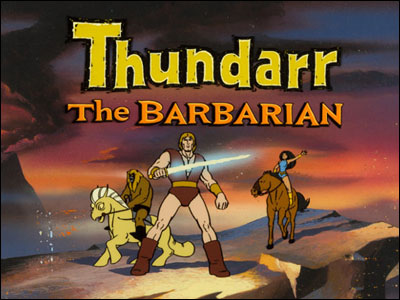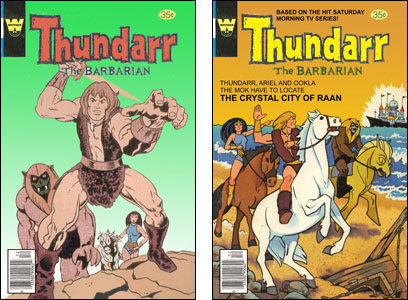
In late 1979, the TV cartoon show Thundarr the Barbarian was developed at the Ruby-Spears cartoon studio in the hope of selling it to ABC for its Saturday morning cartoon show lineup. A bunch of us pitched in on its concept and I think the name "Thundarr" came from me…but my pal Steve Gerber and the studio-head Joe Ruby had way more to do with the series than I did. Alex Toth did the initial designs of the three main characters.
ABC waffled, trying to decide between it and a few other submissions from other studios. An agent for Hanna-Barbera was trying to get me to commit to story-edit one of the shows his studio was pushing for that time slot. I told him I thought Thundarr would be selected and I'd kinda/sorta agreed that if it was, I'd write a third or so of the scripts for it. He told me I was making a big mistake.
Ruby-Spears would later be acquired by the corporation that owned H-B but at the time, they were competitors…and H-B could be pretty ruthless in squeezing competitors off the networks' schedules. He told me there was no f'in' way Thundarr would get on the ABC schedule. Hanna-Barbera had the clout to keep it off and to place the show he was offering me. I decided not to believe him. In hindsight, I'm not sure anything this guy ever told me was accurate.
Joe Ruby decided that maybe more artwork would close the sale but Alex Toth refused to draw another line for it or the studio. Alex was one of the most brilliant artists who ever worked in animation or comic books but he did not play well with others. Some of his many employers over the years treated him poorly and when they did, he would tell them to drop dead and leave him the hell alone. Some of his many employers over the years would treat him like a god and when they did, he would still find some reason to tell them to drop dead and leave him the hell alone.
Another brilliant artist was needed to quickly draw some large, awesome sales presentations that would enchant the network folks. I solved two problems at the same time by suggesting Jack Kirby. The other problem was that Jack was real, real unhappy — legitimately so, not like some of Toth's raging — with how he was being treated in comic books. Trouble was, he couldn't just then find any other way to make a living. He was hired to do the necessary drawings, ABC bought Thundarr…and Ruby-Spears put Kirby under contract for the rest of his career. He was much happier working for them than he would have been in any of the then-feasible alternatives.
I only wrote one episode of Thundarr the Barbarian, plus I wrote the opening titles and helped on a few rewrites. That's because I was suddenly engaged to be the head writer on a prime-time variety show starring two young ladies from Japan who did not speak English. And who could turn that down? Gerber and other folks turned Thundarr into a respectable — that is to say, renewable-for-a-second-season — success. There would have been a third if Garry Marshall, who in 1982 was the most powerful man around ABC, hadn't demanded that the network clear a half-hour in their Saturday AM schedule for a Mork & Mindy cartoon show.
A year later, NBC picked up Thundarr but only for reruns. No new episodes were ever produced. There was talk of an animated feature for which one of the show's best writers, Buzz Dixon, wrote a wonderful screenplay that was never produced. There were samples drawn up for a potential newspaper comic strip that never happened. And there was a comic book that was readied for publication but never published. The other day on Facebook, Jason Moore asked about it after posting this item that ran in Amazing Heroes magazine in its February 1981 issue…
Whitman Comics will be adding a substantial number of titles to its lineup in 1982; most of these will be revivals of old titles, although there will also be one new adventure title (Thundarr, based on the popular Saturday morning cartoon show), and three mystery/fantasy titles, Shroud of Fear, Astral Frontier and Shadow Play.
"Whitman Comics" was the new name for Gold Key Comics, the line produced by Western Publishing, AKA Western Printing and Lithography. During the late sixties and especially throughout the seventies, Western had increasing problems getting their comics distributed. At one point, they were literally not available in the state of New York and also in many other areas.
"Why" is a long story but basically, the system by which magazines had long been distributed was crumbling, at least for publications that didn't have photos of nude women and/or very expensive advertising. Other comic book companies managed to cope in different ways…and had stronger distributors who were elbowing the smaller publishers off the steadily-decreasing number of newsstands across the country. Other comic book companies also had incoming revenue — often, way more than they made publishing — from the licensing of their characters. But Western didn't share in the licensing of the main characters they published — Mickey Mouse, Donald Duck, Bugs Bunny, Woody Woodpecker, etc.
Western was still making money with its lines of coloring books, kids' books, activity books, jigsaw puzzles and other items they produced under the Whitman brand. They tried distributing their comic books along the same lines…which is why the switch from "Gold Key Comics" to "Whitman Comics" but that wasn't working too well. Many of their comics simply and quietly stopped coming out. They did publish one issue of Shadow Play and I think one or two others but never published most of them and never published a traditional sized issue of Thundarr.
Asking about the Thundarr comic, Jason wrote on Facebook, "So does anyone else have any details on this? Mark Evanier, Buzz Dixon, Wiliam Wray…do you guys know any details on the plans for the comic?" I came along and posted the following…
Okay, here's Mark with the answer. During its last few years of operation, the comic book divisions of Western Publishing Company produced dozens and dozens of never-published issues of whatever they were then publishing and also some new comics. Some of that material (mostly the Disney stuff, I suspect) may have been published by overseas publishers. Most of it, I'm sure, was never printed anywhere..
The finished artwork for all or most of that material went into a big pile at the offices of the New York division where it sat for many months while the company, which had stopped sending comics to press, decided if and when to resume and explored different ideas about distribution. They finally decided not to resume.
I saw that pile on a trip to those offices. DC Comics flew Dan Spiegle — then the artist of the Blackhawk comic I worked on for them — and myself and others back to New York for a big conference. Dan and I snuck away for a few hours to visit the Western offices. I, who had written for Western for several years, had been there before. Dan had worked for the company for something like thirty years — mostly for the Los Angeles office but occasionally for New York — and had never been there. It was a sad visit as the once-huge offices had been reduced to two small rooms.
I got to flip through the pile, which was about two feet high. There were several issues of a completed, ready-to-print Thundarr comic book in there. All the ones I saw were drawn by Winslow Mortimer and one had a script credit for John David Warner. He may have written all of them. I was a big fan of Mr. Mortimer's art but I thought he was miscast on this particular book and that he made it look too cartoony.
The pile also had completed issues of Daffy Duck and Pink Panther and whatever else was in the Gold Key/Whitman line when publishing was suspended forever. I have no idea what became of the art in that pile.
So there's all that history. Oh — and you see those covers above of the Whitman Thundarr comic book? They're fake. I made them up in Photoshop a few hours ago. Forgive me if you were fooled.
I've heard rumors that Western did publish one mini-comic of the property that had very limited circulation but I've never seen one. There have been toys of the characters and I believe Thundarr also did a cameo in one of DC Comics' Hanna-Barbera titles. An editor there once asked me if I'd be interested in writing a new comic book of it that was under discussion. I said yes, he said he'd be "in touch" and he's never gotten in touch with me. That just might be because he's no longer in touch with the company.
That's kind of the way most Thundarr plans seem to go but I still think it was a good show and I'll bet it'll be back someday. I'll also bet it won't look much like the show I worked on and that many people seem to remember fondly.
